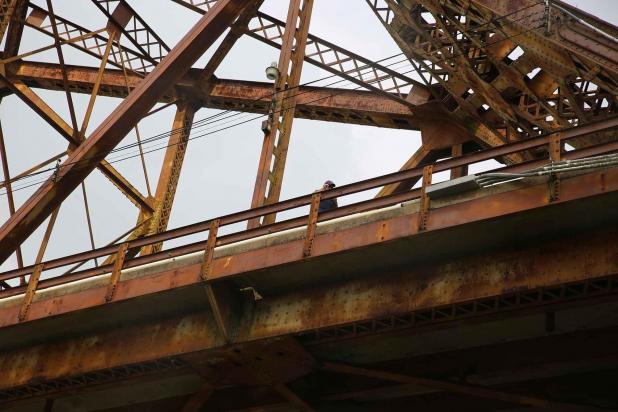
A man walks across the La. 182 bridge Wednesday, looking for a cellphone signal.
The Daily Review/Bill Decker
Bar hopping: Ida shows how much we rely on cellphones
In April, state emergency preparedness officials gathered — virtually, by Zoom — to talk about preparing for hurricanes. And Tim Osborn of the National Oceanic and Atmospheric Administration had a question.
Osborn asked about the availability of emergency cellphone service through mobile equipment if a storm knocks out cell towers. In past hurricanes, the lack of cell service slowed relief workers as they tried to find their way around neighborhoods that were no longer recognizable, Osborn said.
Osborn’s question turned out to be prophetic. As Hurricane Ida knocked out power to millions and flattened structures in a broad swath across southeast Louisiana, first responders turned to technology like portable cell repeaters and drones to do rescue and recovery operations.
The jury is still out.
In St. Mary, something like reliable cellphone service began to return Wednesday.
Then,at mid-morning Thursday, much of the area lost AT&T service again.
It's a work in progress. And it's a reminder that, like the internet, cellphones have become valuable tools for communicating important information to people during emergencies.
AT&T reported that its network was down to 60% Monday, the day after Ida mande landfall.
On Wednesday, the company made this report: “Our wireless network in Louisiana continues to improve and is currently operating at more than 94 percent of normal.
“We continue to focus on restoring service to areas that were hit hardest by the storm, including Lafourche, Tangipahoa and Terrebonne Parishes. We now have a total of 23 on-air mobile cell site solutions supporting customers and first responders. …
“Our teams are also closely monitoring Ida’s storm path in the northeast and any severe weather impacts. We are dedicated to our restoration efforts in Louisiana and will continue to work around the clock until service is restored.”
AT&T said it deployed 13 mobile satellite cell towers on air and have additional assets on the way to areas impacted by the storm.
Also in use:
—Mobile cell sites and mobile command centers like Cell on Wheels (COWs) and Cell on Light Trucks (COLTs).
—Emergency communications vehicles (ECVs).
—Flying Cell on Wings (Flying COWs).
—High water vehicles.
—Amphibious all-terrain vehicles.
—Drones.
—A self-sufficient base camp: This is complete with sleeping tents, bathrooms, kitchen, laundry facilities, an on-site nurse and meals ready to eat (MREs).
—Hazmat equipment and supplies.
—Technology and support trailers to provide infrastructure support and mobile heating ventilation and air conditioning.
—Internal and external resources for initial assessment and recovery efforts.
Also Monday, the Verizon Response Team arrived in southeastern Louisiana to deliver Verizon Frontline technology to first responders conducting search and rescue and disaster response operations in some of the areas hardest hit by Hurricane Ida.
The Verizon Response Team was activated last week and pre-positioned just outside of the expected storm track, enabling a rapid response effort when conditions permitted and allowing the team to quickly distribute mission-critical communication technology to federal, state and local government and public safety agencies operating in storm-damaged areas of Louisiana, the company said.
“Collaborating with emergency management officials across impacted regions of the state, the Verizon Response Team has deployed a wide range of Verizon Frontline technology, including Satellite Pico-cells on Trailers (SPOTs), network extenders, routers, mobile hotspots and phones to provide critical voice and data service to public safety professionals dealing with the devastation left in the wake of the powerful, Category 4 storm.”
Early in the week, T-Mobile said some sites in the hardest hit areas of southeast Louisiana remained offline.
“Fortunately many of them continue to have coverage from adjacent sites and our engineering teams is continuing to make their way to those impacted sites with generators and other emergency equipment,” the company said on its website. “The going is tough with debris, road closures, and other obstructions, but we are working around the clock to restore service as quickly and safely as possible.”
